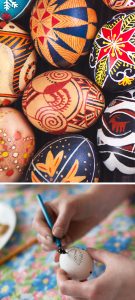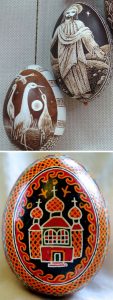
Hey everyone! Easter is just around the corner and even though not everyone celebrates, I want to highlight pysanky eggs. Not only are these decorative eggshells visually stunning, but they also hold deep cultural roots as well. To understand the time and effort that goes into decorating these eggs I will briefly describe the process but if you are super curious, I highly recommend watching a video because it is mesmerizing.
To start, an egg is drained of the whites and yokes (but it isn’t necessary if you don’t plan on keeping it) and a design is drawn onto the shell with pencil. Some people will freehand designs which is even more impressive because I could never. After that, using a tool called a kistka and melted beeswax, a design is then applied to the egg. After the design has been drawn it is placed in the dye, removed, and more designs are drawn. The wax preserves each color beneath it and when the wax is finally removed, ornate patterns and colors are finally revealed.
 This tradition originated in Ukraine pre-Christianity and was performed only by women and young girls. These women would decorate the eggs away from prying eyes and in secret as to avoid curses being placed on their pysanky. The egg, as it is in most cultures, symbolizes fertility and was used to bring good luck, a good harvest, and to ward off evil. As Christianity was introduced, the practice was almost completely banned due to it being deemed a pagan practice, but pysanky were added to Christian tradition so long as religious iconography was used to decorate the eggs. Many of the old symbolism for various gods and goddesses were transformed and gained new meanings in more modern times, and much of the tradition and knowledge had been lost under Soviet rule.
This tradition originated in Ukraine pre-Christianity and was performed only by women and young girls. These women would decorate the eggs away from prying eyes and in secret as to avoid curses being placed on their pysanky. The egg, as it is in most cultures, symbolizes fertility and was used to bring good luck, a good harvest, and to ward off evil. As Christianity was introduced, the practice was almost completely banned due to it being deemed a pagan practice, but pysanky were added to Christian tradition so long as religious iconography was used to decorate the eggs. Many of the old symbolism for various gods and goddesses were transformed and gained new meanings in more modern times, and much of the tradition and knowledge had been lost under Soviet rule.
Luckily for us, scholars have been unable to unearth much of the symbolism used during the pre-Christian era. Although there are no examples of these original designs because of the fragility of an egg, some of these designs have been preserved in wood carving, furniture, and pottery. I tried making pysanky eggs once upon a time and let me tell you it is extremely time consuming, but you don’t need to be extraordinary artistic to try it, it is a very forgiving art form even if a mistake is made. So, if you want to dabble in this tradition, I say give it a go! We could all use a little bit of luck sometimes.




